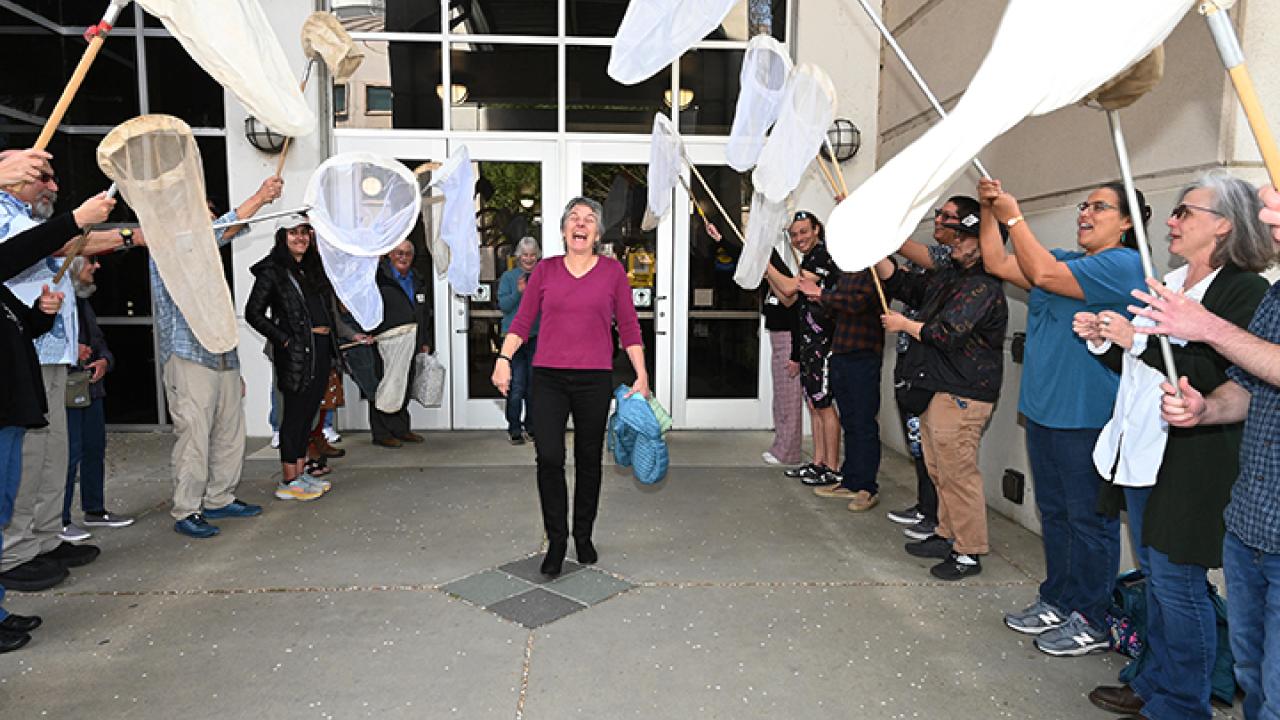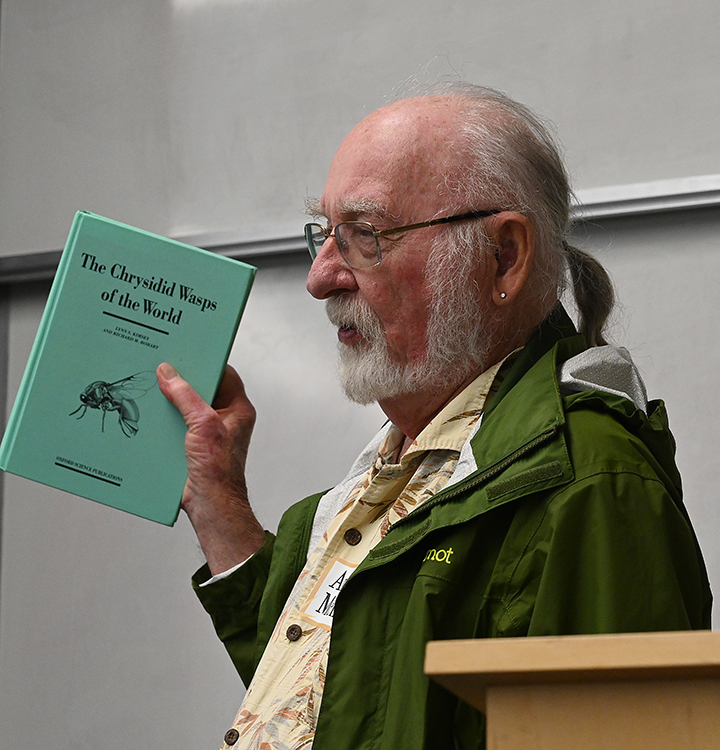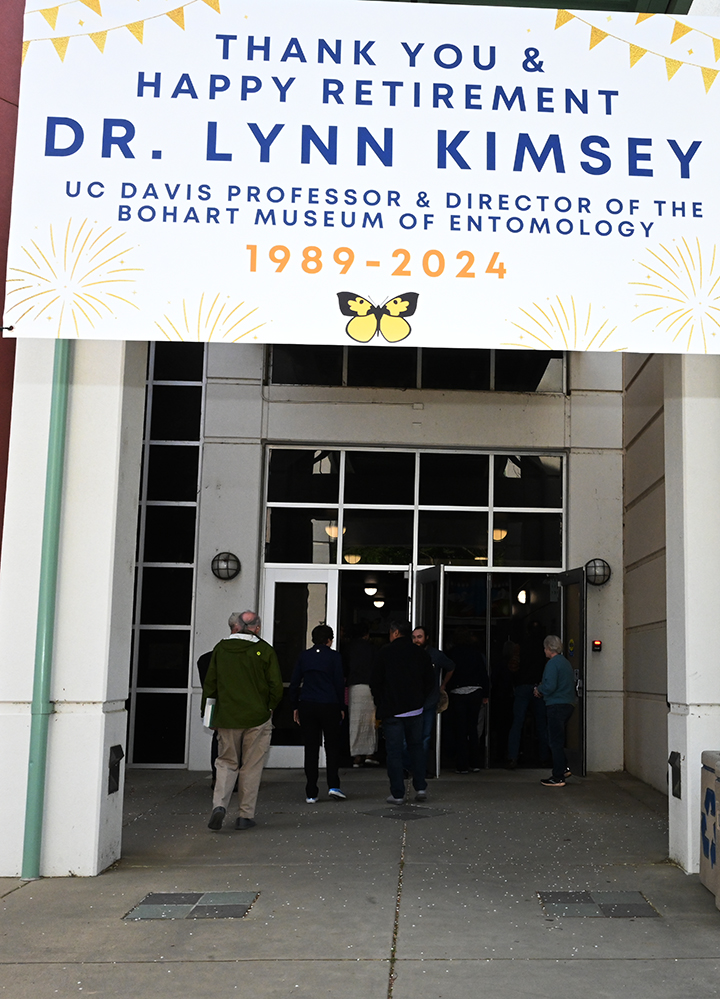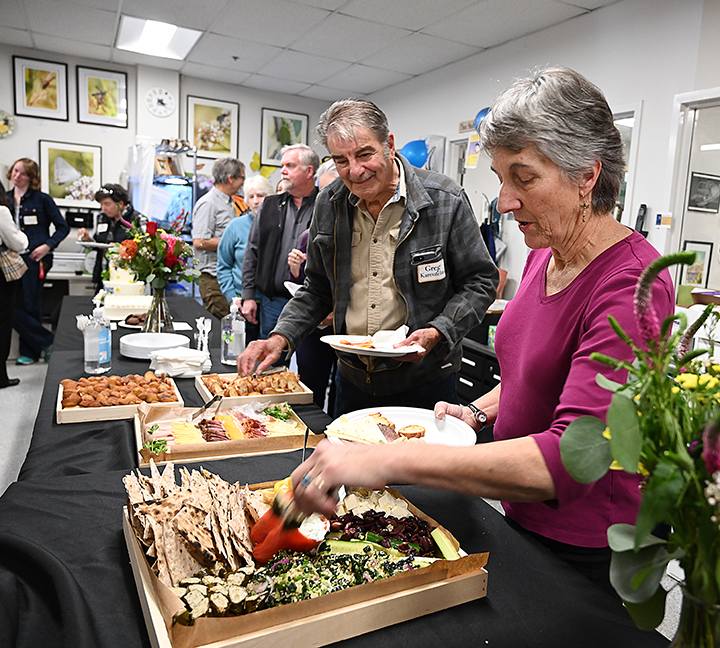
21-Insect Net Salute for UC Davis Distinguished Professor Emerita Lynn Kimsey
Kimsey Served 34 Years as Director of Bohart Museum of Entomology

UC Davis distinguished professor emerita Lynn Kimsey of the Department of Entomology and Nematology, recently received a rousing 21-insect net salute for her entomological expertise and for her 34 years as director of the Bohart Museum of Entomology.
Faculty, colleagues, postdoctoral fellows and students lined up with their nets to form an archway, cheering and clapping as Kimsey walked into the museum--her veritable second home--for a retirement celebration.
Déjà vu: Kimsey remembers when she, as a postdoctoral fellow in the lab of UC Davis professor Richard "Doc" Bohart (1913-2007) lined up with her net in a 21-insect net salute at Briggs Hall in 1986 for the dedication of the newly named Bohart Museum.
"Doc" Bohart founded the museum in 1946 when it included only 400 insect specimens. Under Kimsey’s direction, the facility, now located in the Academic Surge Building on Crocker Lane, houses some eight million insect specimens and is the seventh largest insect collection in North America.
The retirement celebration, hosted at two buildings on Crocker Lane, began with presentations and tributes in a Mathematics Building classroom and ended at the Bohart Museum with food, fun, festivities and more tributes.

Kimsey is a recognized authority on insect biodiversity, systematics and biogeography of parasitic wasps, urban entomology, civil forensic entomology, and arthropod-related industrial hygiene. A UC Davis entomology alumna, she received her undergraduate degree in 1975 and her doctorate in 1979. She was the last graduate student of Professor Bohart.
Kimsey joined the entomology faculty in 1989 and became the Bohart Museum director in 1990. She officially retired Feb. 1, 2024, but continues her insect research and as the executive director of the Bohart Museum Society. She writes and publishes the quarterly newsletter.
The new director, succeeding Kimsey on Feb. 1, is arachnologist and Professor Jason Bond, the Evert and Marion Schlinger Endowed Chair in the Department of Entomology and Nematology and associate dean, College of Environmental Sciences (CA&ES).
“Lynn has had an incredible career of not only scientific accomplishment but unparalleled service to the university and our community,” Bond told the crowd. He described Kimsey’s career as “phenomenal—her contributions to science, the campus, the department, and the museum are, for lack of a better word--amazing--and were transformative. She was a scholar, teacher, department chair, and museum director. She impacted the lives of countless students, colleagues, and citizens across the state of California.”

“Professor Kimsey began her career as a student in entomology when there were few women in the field, particularly who specialized in insect systematics and taxonomy,” Bond related. “Lynn started out as a scientific illustrator (Lynn Siri) reflecting both her amazing and enviable talents as an artist but also the state of science and gender disparities that were pervasive during that time.
“However, Lynn is a brilliant and gifted scientist who landed exactly where she should be--in a Ph.D program at one of the greatest ag institutions in the country where after receiving her PhD, she went on to be a visiting lecturer at Harvard University before returning to Davis. When I think about the challenges that Lynn faced early in her career, it makes me proud and feel privileged to have the opportunity to work with her. And so appreciative that there were women like Lynn who blazed a trail for all of the great women colleagues we now have today in our department and in the fields of insect systematics.”

Kimsey served as president of the International Society of Hymenopterists from 2002-2004, and as a member of the board of directors of the Natural Science Collections Alliance in 2000 and 2001. The Pacific Branch, Entomological Society of America (PBESA) singled her out for its highest honor, the C. W. Woodworth Award, in 2020. She received the PBESA Systematics, Evolution, and Biodiversity Award in 2014 and was a member of "The Bee Team" that won the PBESA Outstanding Team Award in 2013. The UC Davis Academic Senate honored her with its Distinguished Scholarly Public Service Award in 2016 in recognition of her outstanding work. And last year, CA&ES selected her as the recipient of its Exceptional Faculty Award.
Kimsey also served as an administrator for her department: vice chair from 2005-2006 and again in 2009-2010, and as interim chair in 2008-2009.
During her career, Kimsey published more than 140 scientific papers and three books and received more than $9 million in grant funds, including funds from the State of California, the U.S. Department of Agriculture and the National Science Foundation.

“Lynn’s research is exceptional in so many regards," Bond said. "She is one of the few world experts on taxonomically difficult wasps which are showcased in the multitude of her publications which include the description of more than 200 new species and 17 new genera.“
“I cannot overemphasize the importance of the taxonomic work to which Lynn dedicated her career," Bond said. "Taxonomy, the science of describing and classifying species, plays a pivotal role by providing the underlying framework for every biological study--rigorous and repeatable ecological, biochemical, molecular, comparative, evolutionary, and physiological studies would be impossible without accurate species delimitation and a downstream ability to identify those species. Contemporary taxonomists find themselves at the forefront of the battle lines drawn by human-driven climate change and mass extinction due to habitat loss and other factors. As this large and rapid extinction event unfolds, taxonomists are thrust into the unsustainable position of documenting this monumental historical loss of biodiversity and, in some cases, grimly identifying and naming new species already extinct.”

Noting that Kimsey expanded the Bohart Museum from a “modest collection” to more than eight million specimens, Bond pointed out how valuable that resource is to the worldwide scientific community. "People from all of the world visit our collections and borrow material.”
"And," Bond said, "the Bohart Museum has an incredible reputation for outreach and it’s not unusual on numerous weekends throughout the year to see hundreds of people gathered in the hall of Academic Surge to learn about insects, our collections and their importance."
"They also might learning something about spiders," he quipped. (Bond is the president elect of the American Arachnological Society.)
“Lynn was exactly the type of leader that we need to see in ALL museums today," Bond shared. "I have a favorite set of lines from Quentin Wheeler's book, The New Taxonomy in the chapter, Taxonomic Shock Awe,” where Quentin talks about museum leadership, and that we need museum directors who have no doubt in their minds why their institutions exist and why we have and must continue to build collections. Those collections represent most of what we know or will ever come to know of biological diversity. Lynn was exactly the type of museum leader that Quentin was talking about--she worked tirelessly to maintain and grow the collections, advocate to the administration on its behalf, she made those collections accessible to students and taxpayers that support our institution and finally, she was a taxonomist that had a fundamental understanding of the Bohart’s irreplaceable scientific value. Without equivocation I see it as privilege and responsibility to continue that legacy.”
In closing, Bond emphasized "the tremendous impact that Lynn has had--her science, teaching, outreach, and extension has been transformative. And she’s built a museum collection and associated outreach program that is the best in the entire UC system if not the state.”
Other speakers included:
- Fran Keller, professor at Folsom Lake College who received her doctorate in entomology from UC Davis in 2013, studying with Kimsey. Keller, as a Bohart Museum scientist, is conducting a survey of insects in Belize and annually leads or co-leads a collecting team there. She is the designer and impetus behind the many Bohart Museum posters and t-shirts, and authored a children’s book, The Story of the Dogface Butterfly, available in the Bohart gift shop.
- Arnold Menke, who received his doctorate at UC Davis in 1965, studying with Professor Bohart, is known for his wasp expertise and as a research entomologist (now retired) from the National Museum of Natural History. Some 34 new species of insects are named in his honor, along with two genera.

In her presentation, Keller described Kimsey as a talented scientist, science communicator and a friend "and I can never repay her for what I have learned...Being around Lynn was amazing, even though she never switched to beetles,” she quipped. (Keller studied darkling beetles while pursuing her doctorate at UC Davis.)
Menke praised Kimsey for her research on Hymenoptera, her scientific publications, her innovations and open-door policy at the Bohart Museum, and her Bohart newsletter. He said he considers her "most noted accomplishment or most major contribution to the world--the Bohart Museum."
(Editor's Note: Walter Leal, UC Davis distinguished professor of molecular and cell biology and former chair of the Department of Entomology, recorded Lynn Kimsey's speech. It is posted on X (formerly Twitter) at https://x.com/wsleal2014/status/1776732932901863666)
